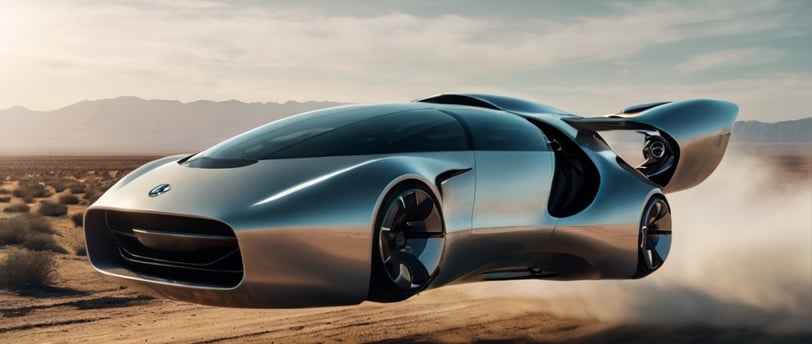The Future of Cars
In the near future, what seemed like sci-fi yesterday will be the norm very soon. Flying cars are in our future
Gadget Gorillaz
7/22/20243 min read


The Future of Cars: Driving Toward a Skyward Revolution
As we embark on a new era of transportation, the future of cars is becoming an increasingly captivating subject. With rapid advancements in technology, changing consumer preferences, and a greater focus on sustainability, the automobile industry is poised for a remarkable transformation. A significant component of this evolution is the concept of flying cars, a long-awaited innovation that promises to reshape our understanding of personal mobility.
The Evolution of Cars
Historically, cars have been the backbone of personal transportation since the early 20th century. Initially, they were gas-powered behemoths that revolutionized travel. Today, electric vehicles (EVs) are leading the charge towards sustainability, driven by innovations in battery technology and a collective desire to reduce carbon emissions. The transition to EVs is just one piece of a larger puzzle that includes advancements in automation, connectivity, and shared mobility.
Autonomous Vehicles: The Road to Tomorrow
Before we explore the skies, it’s essential to understand how automation is transforming ground transportation. Autonomous vehicles (AVs) are being developed by tech companies and traditional automakers alike, promising to enhance road safety and efficiency. With technologies such as lidar, machine learning, and advanced sensors, AVs can navigate complex environments with minimal human intervention.
The proliferation of autonomous cars is expected to result in fewer accidents, reduced traffic congestion, and optimized urban planning. Car ownership may also shift away from individual ownership models towards shared services, changing the landscape of transportation drastically.
The Vision of Flying Cars
The concept of flying cars—also known as vertical take-off and landing (VTOL) vehicles—has long been the stuff of science fiction. However, several companies are actively working to make this dream a reality. Startups and established firms alike are developing prototypes that could operate in urban environments, alleviating ground congestion and providing a new dimension to personal mobility.
Companies such as Terrafugia, PAL-V, and Joby Aviation are pioneering the development of flying cars and eVTOL aircraft. The appeal of flying cars lies in their potential to bypass traditional traffic routes, dramatically reducing commute times and providing efficient access to urban centers. Imagine a future where your daily commute could involve a quick flight above the traffic below, arriving at your destination in mere minutes.
Regulatory and Technical Challenges
Despite the excitement surrounding flying cars, several challenges must be addressed before they become a commonplace aspect of our streets and skies. Regulatory hurdles are among the most significant obstacles. Air traffic regulations, safety standards, and airspace management will need substantial overhauls to accommodate the influx of flying vehicles.
Moreover, technical challenges such as battery efficiency, noise reduction, and infrastructure development for takeoff and landing locations must be tackled. Cities may need to adapt their landscapes to include vertiports, dedicated areas for flying cars to land and take off.
The Role of Urban Air Mobility
Urban Air Mobility (UAM) is a burgeoning field focused on integrating flying vehicles into urban transport networks. UAM aims to provide more efficient transportation solutions by leveraging airspace to decrease travel times in densely populated areas. This concept has the potential to help with urbanization issues, ensuring that cities can accommodate growing populations without exacerbating traffic woes.
Innovative projects, such as air taxis and healthcare aerial transport, are already piloting the concept of UAM. By enabling rapid patient transport or efficient delivery of goods, flying vehicles could play a critical role in urban life in the coming years.
Environmental Implications
The future of cars also raises questions about sustainability and environmental impact. As vehicle design evolves, there is a growing emphasis on electric propulsion systems for both cars and flying vehicles. Sustainable practices will be paramount if flying cars are to contribute positively to our environment. By prioritizing clean energy sources and materials, the automotive industry can align its advancements with global efforts to combat climate change.
The wrap up: Soaring into the Future
The future of cars is bright and filled with possibilities. Flying cars are not merely a fantastical idea; they represent an exciting frontier in personal transportation. As advances in technology and regulatory frameworks converge, we may soon witness a blend of autonomous, electric, and airborne vehicles transforming how we navigate our world.
Though we may still be several years away from widespread adoption of flying cars, the groundwork is being laid today. As we develop smarter, cleaner, and more efficient modes of travel, the prospect of soaring above our cities in personal flying machines becomes increasingly tangible, heralding a new age of mobility that could redefine what it means to be on the road—or in the sky.
